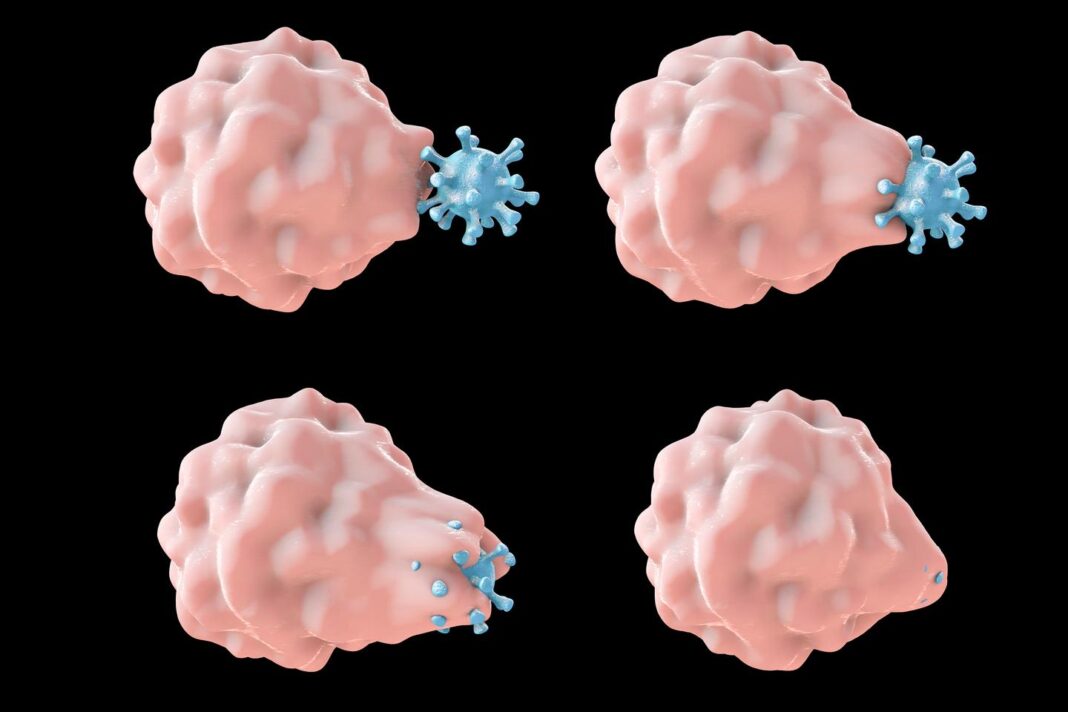Following a trail of evidence that started with a study of fruit flies nearly 25 years ago, researchers have found adding a hyperactive form of the protein Rac2 to macrophages, immune cells that eat pathogens, causes them to cannibalize T cells. The novel technique could potentially boost the effectiveness of an emerging cancer treatment. Rac proteins have been around for a long time.
Deeply conserved in evolution, the proteins are thought to have been present in the earliest nucleated cells. But, despite their age, scientists are still uncovering their mysteries. In a new study, researchers from the University of California Santa Barbara (UCSB) discovered more about how Rac proteins work and how they could potentially improve cancer treatment.
The human genome encodes three Rac proteins. Rac1 is expressed ubiquitously, Rac2 is expressed predominantly in cells that produce blood components (hematopoietic cells), and Rac3 is expressed primarily in brain tissue. Back in , researchers studying fruit flies found that the proteins were instrumental in cell movement and that a hyperactive form of Rac1, expressed in only a few cells in a fly’s egg chamber, destroyed the whole tissue.
“Just expressing this active Rac in six to eight cells kills the entire tissue, which is composed of about 900 cells,” said Abhinava Mishra, the current study’s lead author. That was as far as the researchers got in the ’90s. It wasn’t until a few years ago that research started to emerge suggesting that cannibalism might be the cause of this tissue destruction.
In , a study published in the journal reported on three unrelated people with recurrent infections and a significant lack of T cells, specialized white blood cells crucial to the immune system, had the same mutation that hyperactivates Rac2. The study also observed that many of the patient’s neutrophils, cells that capture and ingest invading microorganisms, were enlarged, indicating they were consuming a lot of cellular material. After reading this study, Denise Montell, who was involved in the 1996 research and is the corresponding author in the current study, wondered whether the T cells’ disappearance was due to innate immune cells with active Rac2 eating them, as had happened with the fruit flies.
So, Montell and the other researchers turned their focus to macrophages, the voracious counterpart of the neutrophil. The researchers cultured human macrophages with and without hyperactive Rac2, together with T cells, and found that macrophages with hyperactive Rac consumed more cells, confirming their hypothesis. Then, using bone marrow samples from mice with the same hyperactive Rac2 mutation seen in the 2019 study patients, the researchers grew bone marrow stem cells into macrophages.
A similar experiment was performed, but this time mixing both macrophages and T cells with and without the Rac2 mutation. They found that not only did macrophages with active Rac consume significantly more T cells, but T cells with active Rac2 were also more vulnerable to consumption, whether they had the mutation or not. They next grew macrophages from the bone marrow of normal and mutant mice with activated Rac2.
In each group, the macrophages were made to express either a dummy receptor or the chimeric antigen receptor (CAR), which are designed to target B cells, another type of immune cell. They found that macrophages with dummy receptors did not eat many B cells; however, the macrophages with both hyperactive Rac and CAR ate twice as many B cells as the CAR-only group. Activated Rac2 also seemed to increase the number of so-called ‘super-eaters’ – ravenous macrophages that eat and kill multiple cancer cells.
“If you add active Rac without the right receptor, it doesn’t do anything,” Montell said. CAR-T is a current cancer immunotherapy for cancers that uses a patient’s own T cells and engineers them, adding the CAR to help the cells attach to a specific cancer cell antigen, which the cells target and attack. The therapy is highly effective against some cancers, such as leukemia and lymphomas, but there are solid-tumor cancers that do not respond to it.
CAR-M, a newer relative of CAR-T that relies on macrophages instead of T cells, has recently been used in clinical trials and, so far, has been deemed safe. A limitation of CAR-M, however, is that CAR macrophages tend to ‘nibble’ on cells rather than engulfing and eating them. Therefore, enhancing whole target cell consumption is an important goal.
The researchers are interested in harnessing Rac-enhanced CAR macrophages – which they called ‘RaceCAR-M’ in a provision patent – to increase the effectiveness of CAR-M treatments. They also plan to continue their research to investigate whether their novel technique, which proved effective in the lab, will translate to freshly collected human immune cells and animal cancer models. And they’re exploring how Rac2 acts at a molecular level to exert its effects.
“We had this 25-year-old cold case in fruit flies, and we solved it,” said Montell. “And that helped us solve the mystery of an unexplained human immunodeficiency. And then we harnessed that knowledge to enhance a potential cancer immunotherapy.
It was just one mystery after another, and Rac turned out to be the answer to each of them. ” The study was published in the journal . Source: via.
From: newatlas
URL: https://newatlas.com/medical/rac2-protein-macrophages-cannibalize-t-cells-cancer-immunotherapy/



